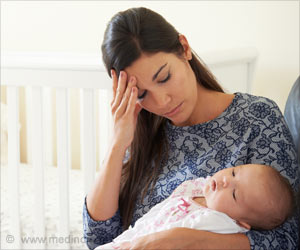
Brain Networks Reveal Signs Of Postpartum Psychosis
There are currently no biological markers that help to identify women who could go on to develop postpartum psychosis, and the role of brain connectivity – how different areas of the brain talk to each other, measured using brain scans – is yet to be fully explored.
‘Subtle differences in brain connectivity could offer a sign of risk for postpartum psychosis in women. The exact mechanisms by which these brain scan changes are related to the interaction between the mothers and their babies, and also how the babies develop during their first years of life is being explored.’
Researchers from the Institute of Psychiatry, Psychology & Neuroscience (IoPPN) at King’s College London, and the University of Padova in Italy, found that compared with healthy women, women at risk of postpartum psychosis show altered connectivity in brain networks associated with ‘goal-directed behaviour’ – i.e. areas of the brain involved in planning, organising and completing short and long-term tasks.
Their study also offers the first evidence that increased connectivity within the brain’s executive network (responsible for attention, working memory and decision-making) could represent a marker of resilience to postpartum psychosis relapse.
32 women ‘at risk’ of postpartum psychosis, and 27 healthy women, were followed up from pregnancy through to eight weeks after giving birth. They were considered ‘at risk’ of postpartum psychosis if they had a diagnosis of bipolar disorder or schizoaffective disorder, or if they had suffered a previous episode of postpartum psychosis.
In the first four weeks after delivery, 15 women became unwell with symptoms indicating postpartum psychosis. Eight weeks after giving birth, the women had brain scans while resting, followed by further scans during an emotional processing task, to study how different brain areas were activated, and the interplay between them.
For the task, participants looked at images of faces expressing different emotions and had to identify that emotion (for example, a face showing a fearful expression). The researchers measured how long it took for them to successfully identify these emotions and analysed how different networks of the brain were activated.
All women at risk of postpartum psychosis, and particularly those who later became unwell, struggled more with understanding and decoding negative emotions, compared to the healthy women. This was indicated by reduced connectivity between certain brain networks during the task, and longer reaction times to the negative emotional images.
While similar connectivity changes have also been revealed in patients with other psychiatric disorders, the King’s study found that these changes were more marked specifically in women who become unwell, potentially reflecting the emotional instability women experience during the course of the disorder.
“Although rare, postpartum psychosis is a very serious mental health problem that can be really frightening for new mothers, their partners, friends and family. Previously, it’s been difficult to spot women at risk of postpartum psychosis or explain why some are more vulnerable than others, as we really haven’t known enough about the neurobiology of the illness. Our study is the first step towards a better understanding of brain connectivity as a marker of vulnerability to postpartum psychosis. Higher levels of cortisol (the main stress hormone) in the third trimester of pregnancy predicted postpartum psychosis relapse. If subtle alterations in the brain’s executive network, and its interaction with other brain areas, were also detectable in pregnancy, these could offer vital clues to the development of postpartum psychosis. Potentially, this could enable us to intervene earlier, allowing clinicians to provide the best possible support for new mothers, before the onset of symptoms,” says Paola Dazzan, Professor of Neurobiology of Psychosis at King’s College London.
The researchers are now planning to study how these brain scan changes are related to the interaction between the mothers and their babies, and also how the babies develop during their first years of life.
Source: Medindia
Stay connected with us on social media platform for instant update click here to join our Twitter, & Facebook
We are now on Telegram. Click here to join our channel (@TechiUpdate) and stay updated with the latest Technology headlines.
For all the latest Health News Click Here
For the latest news and updates, follow us on Google News.

